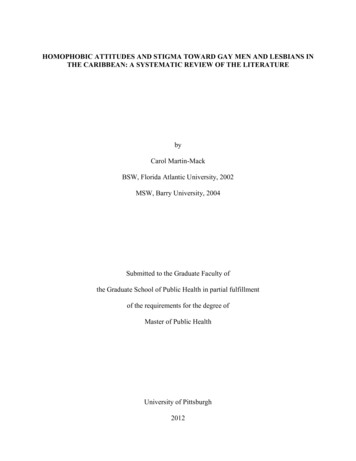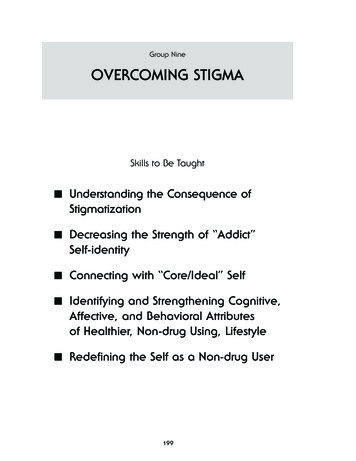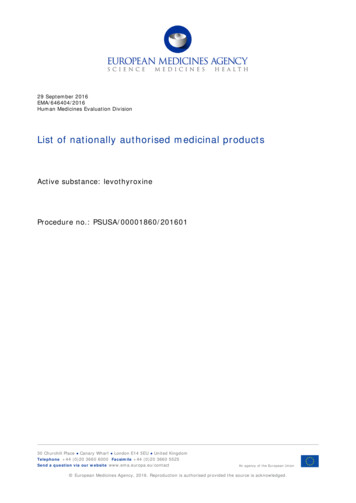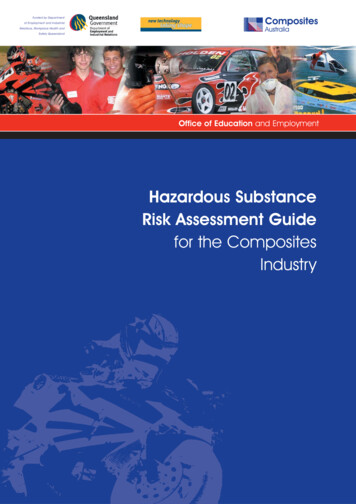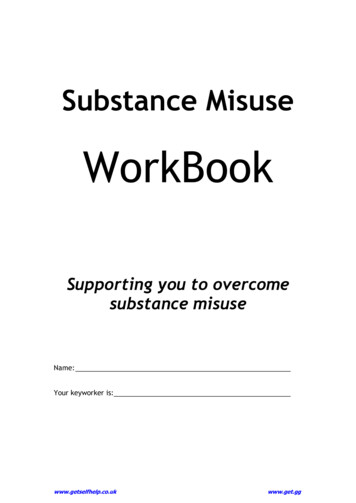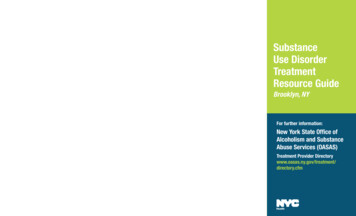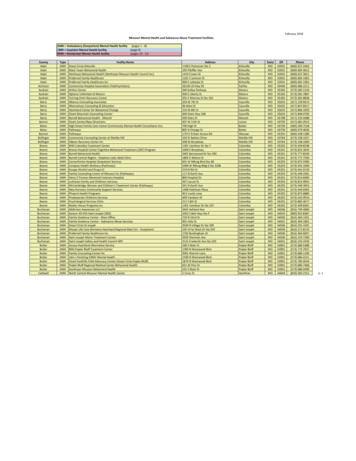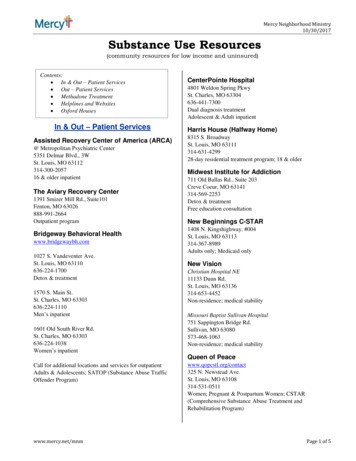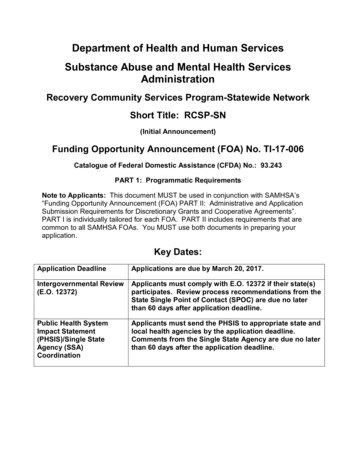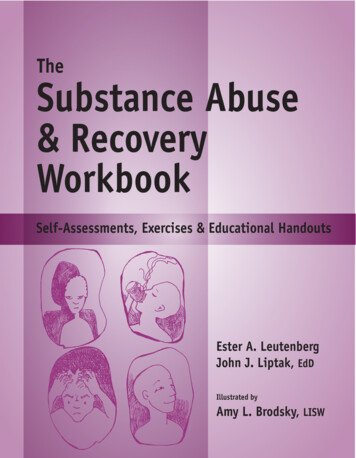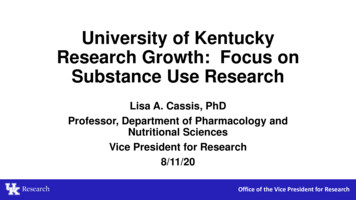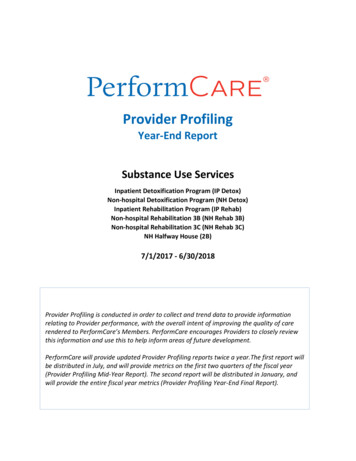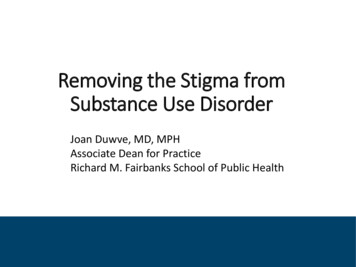
Transcription
Removing the Stigma fromSubstance Use DisorderJoan Duwve, MD, MPHAssociate Dean for PracticeRichard M. Fairbanks School of Public Health
Learning Objectives Recognize the impact of Stigma on getting people intotreatment for SUD. Recognize the importance of using non-stigmatizinglanguage for substance use and people with SUD.
Summary: How the words we usecan support people on the path to recovery Substance use disorder is a chronic brain disease from whichpeople can and do recover. Persistent stigma still creates barriers to treatment andrecovery. The White House ONDCP prepared a document which drawsattention to terminology related to substance use that maycause confusion or perpetuate stigma. Executive Branch agencies are encouraged to consider theimportance of language in their communications related tosubstance use.Boticelli,Michael. Changing the Language of g/2017/01/13/changing-language-addiction
Background – Substance Use Substance use (and misuse) impose a devastating healthand emotional burden on individuals, families, communities,States, Tribes, and the Nation. 20.8 million Americans 12 or older have alcohol or otherdrug use disorders. 27.1 million people aged 12 or older report past-monthillicit drug use. 64,000 Americans died from drug overdoses in 2016: 175people every day, 1 person every 8 minutes. 9 out of 10 individuals in need of treatment for a substanceuse disorder do not receive treatment.
Misuse* “Substance misuse” - use of any substance in a manner,situation, amount or frequency that can cause harm to theperson with SUD or to those around them. For some substances or individuals, any use wouldconstitute misuse (e.g., under-age drinking, any use ofillegal drugs). Prescription drug misuse refers to the use of a drug in anyway a doctor did not direct an individual to use it.* Takenfrom Facing Addiction in America: The Surgeon General’s Report on Alcohol, Drugs,and Health. (2016). Glossary p.3-4. U.S. Department of Health and Human Services.
Background – the Brain Substance use disorder is a chronic brain disease from whichpeople can and do recover. Addictive substances can lead to dramatic changes in brainfunction and reduce a person’s ability to control his or hersubstance use.
Stigma Dehumanization of the individual basedon their social identity or participation ina negative or an undesirable socialcategory.Ervin Goffman, Stigma: Notes on the Management of a Spoiled Identity. 1963
Four Identified Types of Stigma Public Endorsement by the public of negative attitudes against a specificstigmatized group, which manifests in discrimination towards individualsbelonging to that group. Perceived Stigmatized individuals think that most people believe commonnegative stereotypes about individuals belonging to the samestigmatized category. Enacted Direct experience of discrimination and rejection from members of thelarger society. Self Negative thoughts, feelings, and diminished self-image resulting fromidentification with the stigmatized group and anticipation of rejectionfrom the larger society.Ervin Goffman, Stigma: Notes on the Management of a Spoiled Identity. 1963
Background – Stigma People with substance use disorders are viewed more negativelythan people with physical or psychiatric disabilities. The terminology often used can suggest that substance usedisorders are the result of a personal failing/choice. The term “abuse” is highly associated with negative judgmentsand punishment. Even trained clinicians are likely to assign blame when someone iscalled a “substance abuser” rather than a “person with asubstance use disorder.” Negative attitudes among health professionals have been foundto adversely affect quality of care and subsequent treatmentoutcomes.
Scott County Focus Group “I love them (Syringe Exchange Staff) to death. They’renice people. They don’t look down on you, because we’rejust drug users. A lot of people think you’re trash becauseyou’re an IV drug user [but] they don’t. It’s the best thing. Iam happy about it.”(Tracy, F2)
Background- Language American Society of Addiction Medicine and others haverecommended the adoption of clinical, non-stigmatizinglanguage for substance use. “Person-first language” has been widely adopted byprofessional associations to replace negative terms thathave been used to label people with other health conditionsand disabilities. “Person with a mental health condition” or “person with adisability” carry neutral rather than negative connotations,and distinguish the person from his/her diagnosis.
Substance Use Disorder The current Diagnostic and Statistical Manual of MentalDisorders replaced older categories of substance “abuse”and “dependence” with a single classification of “substanceuse disorder.” Terms such as “drug habit” inaccurately imply that a personis choosing to use substances or can choose to stop.
Person with a Substance Use Disorder Person-first language is the accepted standard for discussingpeople with disabilities and/or chronic medical conditions. Use of the terms “abuse” and “abuser” negatively affectsperceptions and judgments about people with substanceuse disorders. Terms such as “addict” and “alcoholic” can have similareffects. Using the terms “addicted babies” or “NAS babies”stigmatizes both the baby and the mom.
Person in Recovery Various terms are used colloquially to label the people withSUD, including the terms “clean” and “dirty.” Instead of “clean,” “negative” (for a toxicology screen) “not currently using substances” (for a person) Instead of “dirty,” the term “positive” (for a toxicology screen) “currently using substances” (for a person) The term “person in recovery” refers to an individual who isstopping or at least reducing substance use to a safer level,and reflects a process of change.
Medication-Assisted Treatment Terms “replacement” and “substitution” have been used toimply that medications merely “substitute” one drug or“one addiction” for another. This is a misconception. The dosage of medication used in treatment for opioid usedisorder does not result in a “high,” rather it helps to reduceopioid cravings and withdrawal. “Medication-assisted treatment” (MAT) is used to refer tothe use of any medication approved to treat substance usedisorders combined with psychosocial support services.
UNDERSTANDINGOPIOID USE DISORDEROutreach Presentation
How Do Opioids Work?Opioids work by:1) Binding to brain receptors2) Minimizing the perception of pain3) Stimulating “reward” centers in the brain4) Triggering feelings of pleasure, relaxationand euphoria#KnowTheOFacts
#KnowTheOFacts
#KnowTheOFacts
What is the Most EffectiveTreatment Option?Medication-Assisted Treatment (MAT)Combines prescribed medication andbehavioral therapies to treat opioid usedisorder#KnowTheOFacts
#KnowTheOFacts
What can you do toreduce the stigma?#KnowTheOFacts
Language mattersSAY THISNOT THISPerson withOpioid Use DisorderDiseasePerson living in recoveryAddict, user, druggie,junkie, abuserDrug habitEx-addictPerson arrested for adrug violationDrug offenderSubstance dependentHooked#KnowTheOFacts
Language mattersSAY THISNOT THISMedication is a treatment toolMedication is a crutchHad a setbackMaintained recovery;substance-freeRelapsedStayed cleanSources: Office of National Drug Control Policy, Changing the Language of Addiction., 01/09/17.National Council for Behavioral Health, Language Matters, September 2015.#KnowTheOFacts
In Review Know the “O” facts Opioid Use Disorder is a Disease There is Treatment Recovery is Possible Be aware of your attitudes and behavior Choose your words carefully Avoid Hurtful labels Be kind to everyone#KnowTheOFacts
In Review Educate others Be supportive, include everyone Replace negative attitudes withevidence-based facts Offer compassionate support Treat people with Opioid Use Disorderwith dignity and respect#KnowTheOFacts
UNDERSTANDINGOPIOID USE DISORDERwww.IN.gov/recovery 2018
Direct experience of discrimination and rejection from members of the larger society. Self Negative thoughts, feelings, and diminished self-image resulting from identification with the stigmatized group and anticipation of rejection from the larger society. Ervin Goffman, St
